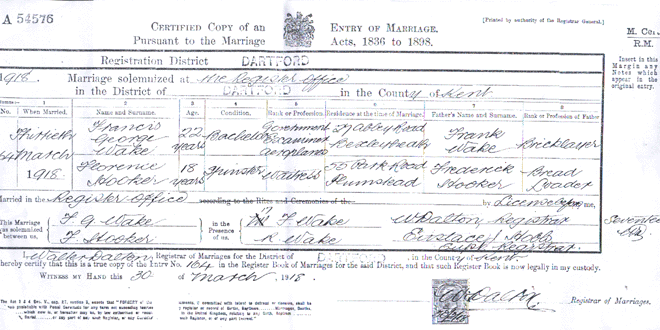Documents
This is what a British birth certificate looks like. They
don't change much. This is my grandfather's from 1895 and my son's in 1992
was virtually the same. This is known as the "long" certificate. A smaller
one is available (it's cheaper) but you need the long one for details.


Zoom In
Starting at the top, it gives you the registration district
and the year. then in section 1 is the full date. In section two the given
name or names of the child, and in section 3 the gender. Section 4 gives the
father's name. In 1895 it would be assumed that the child take his father's
surname. Times have changed. If the child was illegitimate this section may
be blank, but not always. Some men happily gave their name to a child born
out of wedlock. Section 5 is invaluable as it gives the mother's maiden name.
This is the clue that census returns don't provide, and the main reason you
often cannot get by without getting hold of a copy of the certificate. Section
6 gives the father's occupation. This is useful for corroborating with census
returns, especially if names are common and dates uncertain. If you
zoom in the small print gives some fascinating insight into costs!
Now here's a marriage certificate, again almost the same as my own.

This gives us father's names and the fathers' and the happy couple's occupations. It also gives us the couples' ages, and marital status, which may be vital if trying to ascertain whether this was a second or subsequent marriage for either of them. Here also, in addition to the precise date, and the registration district we have the actual home addresses of both parties. In an area like Greater London where registration districts changed over time, even into different counties, this can help quite a bit, sorting out all those mystifying discrepancies on other documents. "Where born" seems to bring out the worst in people's memories.
Now here's a marriage certificate, again almost the same as my own.

This gives us father's names and the fathers' and the happy couple's occupations. It also gives us the couples' ages, and marital status, which may be vital if trying to ascertain whether this was a second or subsequent marriage for either of them. Here also, in addition to the precise date, and the registration district we have the actual home addresses of both parties. In an area like Greater London where registration districts changed over time, even into different counties, this can help quite a bit, sorting out all those mystifying discrepancies on other documents. "Where born" seems to bring out the worst in people's memories.